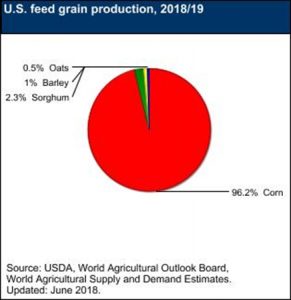Leah Roter
The Agricultural Industry has a huge impact around the United States; from the food that is eaten to the clothes that we wear, the Agricultural Industry plays a major role of where and how our everyday items are obtained. According to the United States Department of Agriculture, by 2017, approximately $132.8 billion dollars made up the United States Gross Domestic Product (GDP) from farm output alone. Out of all the produce grown, corn makes up the majority of the produce in the United States.
Corn has been a nationwide crop for decades, and over the years corn production has skyrocketed. With the increase in advanced technology, engineers have made it more efficient to plant corn. According to the United States Department of Agriculture, by 2017, corn made up 95% of the grains that Americans produce and use. In addition, 90 million acres of land have been used to plant corn alone.


Corn is used for a lot of purposes; most Americans citizens know that corn is in most of the food products that we eat which includes artificial sweeteners and oils. However, many Americans are not informed that corn is used for ethanol fuel. Due to the strong demand for ethanol production, corn farmers have expanded corn production across the United States, which also raises the price for US consumers as well. According to Scott Faber’s article regarding corn ethanol, due to the increase of corn production, corn farmers need “more water to irrigate crops, causing more fertilizer to wash off farm fields and destroying more habitat that supports wildlife – and millions of jobs” (Faber, Corn Ethanol). As a result of the dramatic usage of ethanol, there is more carbon dioxide that is being released into the atmosphere, which creates an environment that is toxic to the natural world.
As a nation where we rely heavily on technology and efficiency, how can we become more sustainable? Our daily routines have an impact on the environment, which can be as simple as leaving the car on while waiting to pick up a friend. However, if we become more aware of the bad habits that are picked up over several years, it is possible to turn those bad habits into good deeds that could have a positive impact on our environment.
Sources:
https://www.ewg.org/agmag/2013/02/corn-ethanol-bad-farmers-consumers-and-environment
https://www.ers.usda.gov/topics/crops/corn-and-other-feedgrains/feedgrains-sector-at-a-glance/
https://www.ers.usda.gov/data-products/ag-and-food-statistics-charting-the-essentials/ag-and-food-sectors-and-the-economy/
http://www.stopforcefeeding.com/content/environmental-impact